Many large businesses and institutions have multiple Facebook pages that post their own content. However, there are times when all of a company’s Pages are on the same page (bad pun) and want to share a video across all their Facebook accounts. Oftentimes, Pages will either hit “Share” from another Page or undergo the tedious task of downloading a copy of the video to upload on their end. For these large-scale institutions, Facebook offers a way for multiple Pages to use a single video file, without having to make multiple uploads. The feature is called “Crossposting,” and most importantly, it boosts a video’s reach for the benefit of all Pages combined.
What is Crossposting?
It’s a feature on Facebook that allows multiple Pages or accounts to post the same video on their feeds. A single upload of a video file can be posted across numerous Pages, without having to upload multiple copies of a video across various accounts.
Crossposting is not the same as sharing. Instead, when you crosspost a video, even if it was uploaded by a different page, it looks as though you shared it natively if you crosspost. A native video is a video that is uploaded directly to Facebook, instead of a video that’s shared through another page or a link from YouTube or Vimeo.
Here’s a summary from Facebook:
“Our publishing partners often like to create multiple Pages to engage different audiences on Facebook. Many of these partners reuse the same videos across different posts and Pages, and they’ve told us they’d like to see total performance insights for a single video across all the places it was used. For example, a media company might want to post a video on their main Page, their international Page, and one of their topical Pages. Then they might also want to repost that same video a few weeks later.”
Benefits of crossposting
The biggest benefit of re-using videos that have already been posted is the aggregation of all the view-counts from multiple feeds. In other words, all the views from crossposting are consolidated into one view-count, which can help with overall exposure within the Facebook algorithm. The combination of views can get a boost from Facebook’s algorithm, generating even more views.
Another benefit of crossposting is that the video appears that it came from your page and not as a shared post. Video posts that appear original or native also have a greater reach than sharing a video from another page or link. Facebook’s algorithm prioritizes original posts over shared posts.
Finally, it’s a time-saver. Crossposters do not have to upload the video, captions, and thumbnail once the original video is posted. You can, of course, tweak the title, captions, and post text if needed for a specific page.
To enable crossposting, establish a relationship
Crossposting is a simple process. You’re either uploading a video and enabling it for crossposting or you’re crossposting a video uploaded and enabled by another page.
So how do you set this up? You have to set up a crossposting relationship, which will then open up a crossposting library for all your pages to crosspost content. Also, it’s very simple to do.
Below are three how-to’s: establishing a relationship, enabling your videos for crossposting, and crossposting videos from others. Before diving in, you have to be an Admin of your Page in order to access these features.
How to establish a crossposting relationship
- Go to your Page’s “Settings.”
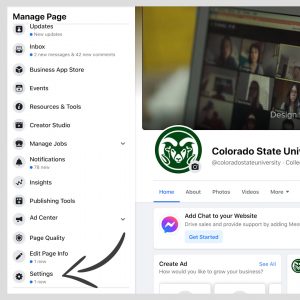
- Click “Crossposting” in the left column. Type in a Page’s name or URL and select from the dropdown list.
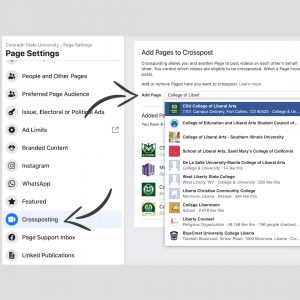
- Choose an option for “Live Videos.” We recommend choosing the option to allow for your Page’s Admins or Editors to approve any live videos before they are crossposted. “Non-Live” videos will appear in Video Library>Videos You Can Crosspost once the other page accepts the relationship.
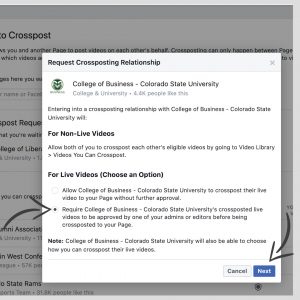
- Once you hit “Next,” you will be provided a link to send to the other Page’s Admin to confirm the crossposting relationship. You can also find the link under “Pending Crosspost Requests.”
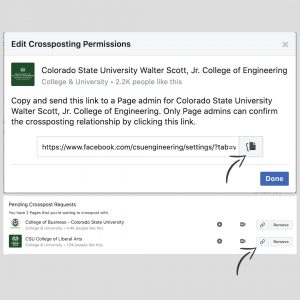
How to upload and enable your video for crossposting
- Once a crossposting relationship is established, you can upload a video for others to crosspost. Go back to your Page and go to “Creator Studio” on the left hand Page menu.
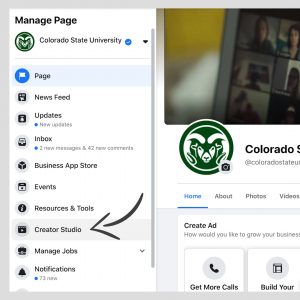
- At the top, click “Upload Video.” Select “Single Video” for one video and hit “Open.” A “Upload Video” window will open for you to add details like a title, post-text, captions, thumbnail, and more under the “Create Post” tab. Next to that tab is a “Publishing Options” tab. Here you will enable crossposting.
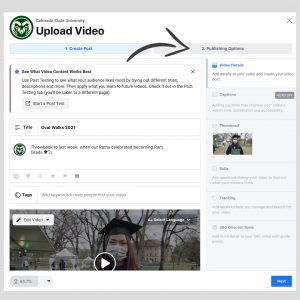
- Under “Publishing Options,” scroll down to “Make Available to Other Pages” and select the relevant pages for crossposting. Hit “Publish” or “Schedule.”
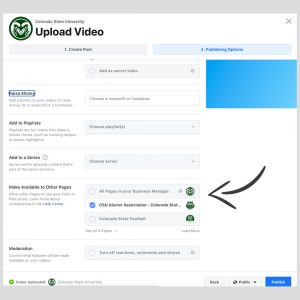
Crosspost another Page’s video
- To crosspost another Page’s video, go to “Creator Studio” and select “Content Library.” From the dropdown menu, select “Videos You Can Crosspost.” From there, you will find all the videos that other pages have enabled for you.
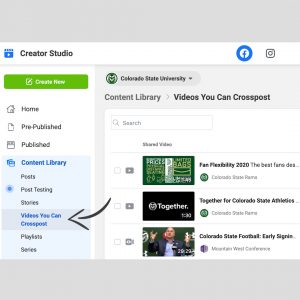
- Click on the thumbnail or post of the video you would like to crosspost. Select “Create Post With This Video” in the prompted window. Following that, you will be able to edit the title, post-text, thumbnail, etc., to fit your Page’s needs.
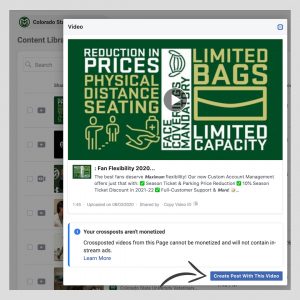
Final takeaways
A key thing to remember is that crossposting is specifically designed for organizations that have multiple Facebook pages that upload the same content to more than one page. There has to be an obvious relationship between each party, whether they’re from the same organization or share rights or involvement in the crossposted content itself. Crossposting allows Pages to consolidate views to reap in the same algorithmic benefits in one video across each company Page. Finally, once a crossposting relationship is established, there’s a lot of flexibility. You don’t always have to crosspost every single video. Like any post, put your Page’s audience first when choosing to crosspost.